This article covers the various forms of transport in the United Arab Emirates (UAE), by road, rail, air, water, etc.
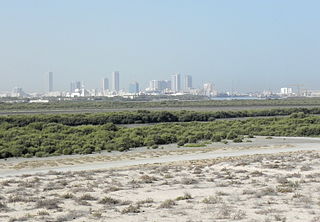
Umm Al Quwain is one of the seven constituent emirates in the United Arab Emirates, located in the north of the country. It is the second smallest and least populous Emirate in the UAE. The closest body of water near it is the Persian Gulf. The emirate is ruled by Saud bin Rashid Al Mualla. The current crown prince is Rashid bin Saud bin Rashid Al Mua'lla, and the deputy ruler is Abdullah bin Rashid Al Mualla III. It had 72,000 inhabitants in 2007 and has an area of 770 km2 (300 sq mi).
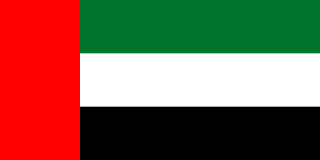
The flag of the United Arab Emirates contains the Pan-Arab colors red, green, white, and black. It was designed in 1971 by Abdullah Mohammed Al Maainah, who was 19 years old at that time, and was adopted on 2 December 1971. The main theme of the flag's four colors is the unity of Arab nations. In 2008, there was a minor change to the Emblem.

Lorentz National Park is a national park located in Papua, Indonesia, in the southwest of western New Guinea. With an area of 25,056 km2 (9,674 mi2), it is the largest national park in southeast Asia. In 1999 Lorentz was declared a World Heritage Site by UNESCO.
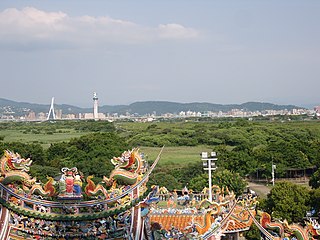
An Important Bird and Biodiversity Area (IBA) is an area identified using an internationally agreed set of criteria as being globally important for the conservation of bird populations.

Roebuck Bay is a bay on the coast of the Kimberley region of Western Australia. Its entrance is bounded in the north by the town of Broome, and in the south by Bush Point and Sandy Point. It is named after HMS Roebuck, the ship captained by William Dampier when he explored the coast of north-western Australia in 1699. The Broome Bird Observatory lies on the northern coast of the bay.
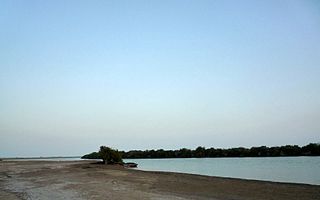
Kalba is a city in the Emirate of Sharjah in the United Arab Emirates (UAE). It is an exclave of Sharjah lying on the Gulf of Oman coast north of Oman. Khor Kalba, an important nature reserve and mangrove swamp, is located south of the town by the Omani border.

Ras Al Khor Wildlife Sanctuary(Arabic: رَأْس ٱلْخَوْر, romanized: Raʾs Al-Khawr) is a wetland reserve in Dubai, the United Arab Emirates, renowned for attracting migratory birds in large numbers. The wetlands have large numbers of birds, crustaceans, small mammals and fish.

Exmouth Gulf is a gulf in the north-west of Western Australia. It lies between North West Cape and the main coastline of Western Australia. It is considered to be part of the region of the North West Shelf and in the Canning Basin area.

Khor Khwair is an industrial zone located next to Saqr Port in the city of Ras Al Khaimah, United Arab Emirates (UAE). Located some 25km north of the city, the zone contains marble and concrete manufacturing facilities as well as LPG processing and other industrial enterprises. Saqr Port was inaugurated on 17 September 1977 by the then-Ruler of Ras Al Khaimah, Sheikh Saqr bin Mohammed Al Qasimi - the day after, he attended a ceremony to mark the export of the first five million tons of rock from Ras Al Khaimah.

Al Khor, officially Al Khor and Al Thakhira, is a municipality in the State of Qatar. Al Khor City, the municipal seat, is located in the northeast coast of Qatar, around 50 kilometres from the capital, Doha and it is considered to be one of the major cities in Qatar. Al Thakhira is the second largest settlement in the municipality after Al Khor City.

The Gulf of Oman desert and semi-desert is a coastal ecoregion on the Persian Gulf and the Gulf of Oman in Oman and the United Arab Emirates at the northeastern tip of the Arabian Peninsula. The climate is hot and dry, with gravelly plains and savanna with thorny acacia trees inland from the coast.Along the coast there are mixture of habitats that include mangrove swamps, lagoons and mudflats. The mangrove areas are dominated by Avicennia marina and the savanna by Prosopis cineraria and Vachellia tortilis. Masirah Island is an important breeding area for the loggerhead sea turtle and other sea turtles also occur here, as well as a great variety of birds, some resident and some migratory. There are some protected areas, but in general the habitats have been degraded by the grazing of livestock, especially camels and goats; they are also at risk from oil spills, off-road driving and poaching.
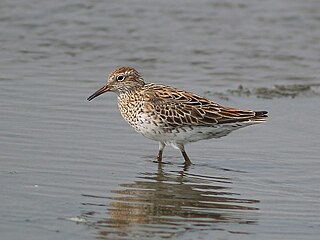
The Port Hedland Saltworks Important Bird Area is a 103 km2 tract of originally intertidal land, now containing a saltern, lying about 20 km east of the port of Port Hedland on the coast of the Pilbara region of north-west Western Australia. The salt processing facility is operated by Dampier Salt Ltd, part of the Rio Tinto Group.
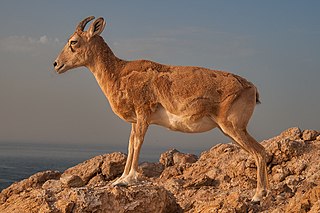
Qatar is a peninsula on the Northeastern coast of the Arabian Peninsula bordering Saudi Arabia to the south and surrounded elsewhere by the Persian Gulf. A strait separates Qatar from the island kingdom of Bahrain.

Meliha Archaeological Centre is a visitor centre and exhibition based around the history and archaeology of the areas surrounding the village of Mleiha in Sharjah, the United Arab Emirates. Built around a preserved Umm Al Nar era tomb, the centre details the excavations and discoveries made over the past 40 years at Mleiha and surrounding areas, particularly the important Faya North East find, which provides evidence that 'anatomically modern humans' were in the Mleiha area between 130,000 and 120,000 years ago. These finds point to the spread of humanity from Africa across the Red Sea to the Persian Gulf region, and onward to populate the world through Iran, India, Europe and Asia.
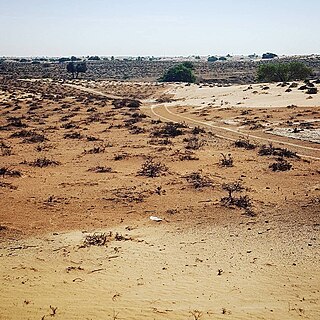
Ed-Dur or Ed-Dour is an Ancient Near Eastern City located in Umm Al Quwain, in the United Arab Emirates (UAE). One of the largest archaeological sites in the emirates, comprising an area of some 5 km2 (1.9 sq mi), the coastal settlement overlooks Al-Beidha Lake. One of the most important archaeological finds in the UAE, It has been dubbed 'one of the most significant lost cities of Arabia'.

Umm Al Quwain Fort, also known as the Al Ali Fort, is located in the city of Umm Al Quwain in the United Arab Emirates (UAE). It was the seat of the rulers of Umm Al Quwain and the centre of government in the emirate until 1969. It was used as a police station before the fort was restored and opened to the public in 2000 by Sheikh Rashid Bin Ahmed Al Mualla, the Ruler of Umm Al Quwain at the time.

Falaj Al Mualla is the inland oasis town of Umm Al Quwain, one of the seven emirates which comprise the United Arab Emirates (UAE).
The Al Mualla family is the ruling royal family of Umm Al Quwain, one of the seven emirates that together comprise the United Arab Emirates (UAE).

The South Iran Nubo-Sindian desert and semi-desert ecoregion covers the northern coastal plain of the Persian Gulf and the inland desert hills south of the Zagros Mountains of Iran. The region also has extensions reaching into southeastern Iraq, and eastward into southwestern Pakistan. The region is one of hot sand deserts, shrubland, and open thorn woodlands inland. Mangrove forests and swamps are found along the coast.




















